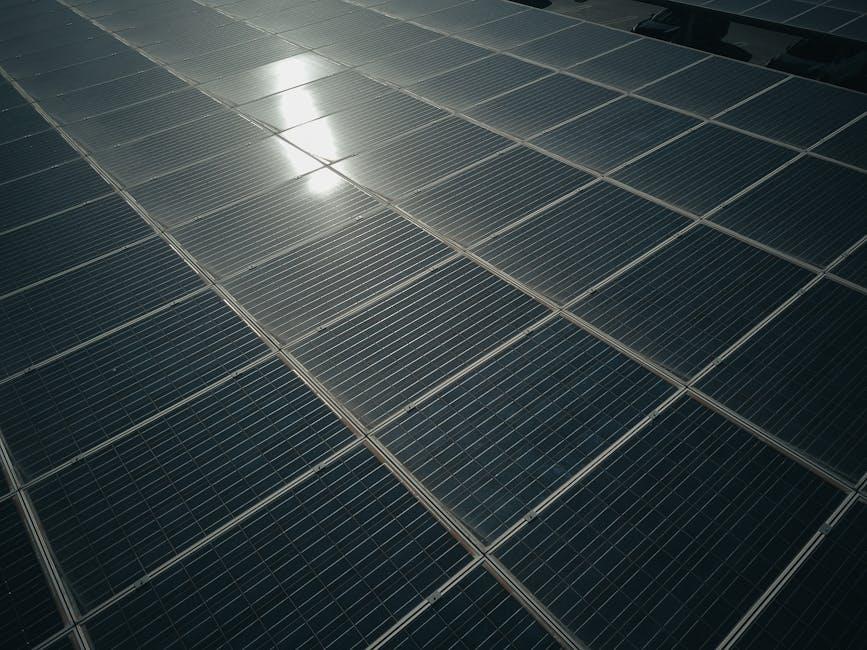In a world increasingly illuminated by the promise of renewable energy, solar power stands as a beacon of hope. Its potential to transform the way we harness and consume energy is immense, offering a path away from fossil fuels and towards a brighter, cleaner future. However, beneath the glimmering surface of solar panels lies a complex web of questions about their true sustainability. As the sun rises on this new era, it’s time to examine whether the production impacts of solar energy cast a shadow on its green credentials. In this exploration, we delve into the lifecycle of solar technology, scrutinizing the environmental costs embedded in its creation and considering the broader implications for our planet. Join us as we journey beyond the sunshine, seeking a balanced understanding of solar energy’s role in our sustainable future.
Evaluating the Environmental Footprint of Solar Panel Manufacturing
When discussing the sustainability of solar energy, it’s crucial to delve into the environmental impact of solar panel manufacturing. While solar panels themselves produce clean energy, the process of making them involves several environmentally taxing steps. Raw material extraction is one of the most significant concerns. The mining of materials like silicon, silver, and rare earth elements can lead to habitat destruction and soil degradation. Additionally, the energy-intensive processes required to purify silicon can result in substantial carbon emissions.
Moreover, the chemical waste generated during production poses another challenge. Various hazardous chemicals, such as hydrofluoric acid, are used in the manufacturing process, and improper disposal can lead to water and soil contamination. It’s essential to consider these factors when evaluating solar energy’s overall environmental footprint. Key considerations include:
- Energy consumption during production
- Waste management practices
- Recycling and disposal of end-of-life panels
Addressing these issues is vital to ensuring that solar energy remains a truly sustainable solution for the future.

Balancing Efficiency and Ecological Cost in Solar Energy Production
As we delve into the realm of solar energy, the juxtaposition between its efficiency and the ecological costs associated with its production comes into sharp focus. While solar panels have become emblematic of clean energy, the production process is anything but spotless. The manufacture of photovoltaic cells involves the use of hazardous chemicals such as cadmium, lead, and hydrofluoric acid, which, if mishandled, pose significant environmental risks. Additionally, the extraction of raw materials like quartz, which is essential for silicon-based solar cells, can lead to deforestation and habitat destruction. These factors challenge the green image often associated with solar energy.
- Energy-Intensive Production: The production of solar panels is energy-intensive, raising questions about the overall carbon footprint.
- Resource Depletion: Mining for raw materials can lead to resource depletion, affecting ecosystems and communities.
- Waste Management: End-of-life disposal of solar panels presents a growing waste management issue, with limited recycling options currently available.
On the brighter side, advancements in technology are paving the way for more sustainable practices. Innovations in solar panel recycling and the development of less toxic materials are promising steps toward reducing the ecological costs of solar energy. The integration of circular economy principles, which emphasize recycling and reuse, can significantly mitigate these impacts. However, achieving true sustainability will require a balanced approach that considers both the environmental costs and the efficiency gains of solar energy. Only by addressing these dual challenges can we ensure that solar power remains a cornerstone of our clean energy future.

Innovative Solutions to Minimize Solar Industry Waste
As the solar industry continues to grow, so does the challenge of managing waste generated from the production and disposal of solar panels. Fortunately, a wave of innovative solutions is emerging to address these environmental concerns. One promising approach involves enhanced recycling techniques that aim to recover valuable materials like silicon, silver, and aluminum from decommissioned panels. By refining the extraction processes, companies can reduce the environmental footprint of panel production while also cutting costs associated with raw material procurement.
Another exciting development is the creation of biodegradable solar panels, which use organic materials that naturally break down over time, leaving minimal waste. Additionally, designing panels for easier disassembly can significantly simplify the recycling process. Some companies are also experimenting with second-life applications for solar components, repurposing them in other sectors such as construction or consumer electronics. By focusing on these innovative strategies, the solar industry can move closer to achieving true sustainability, balancing energy production with environmental responsibility.

Strategies for a Greener Supply Chain in Solar Technology
As the demand for solar technology increases, addressing the environmental impact of its supply chain becomes crucial. Companies can adopt a range of strategies to make their processes more sustainable. One effective approach is to source materials responsibly by choosing suppliers committed to sustainable practices. This includes prioritizing recycled materials and ensuring ethical labor practices in the extraction of raw materials like silicon and rare earth metals.
Additionally, implementing energy-efficient manufacturing processes can significantly reduce the carbon footprint of solar technology production. Manufacturers can invest in modern technologies that minimize energy consumption and waste. Moreover, adopting a circular economy model can enhance sustainability by designing products that are easier to recycle or repurpose at the end of their life cycle. This involves creating take-back programs and working with recycling facilities to reclaim valuable materials.
- Source materials responsibly
- Implement energy-efficient manufacturing
- Adopt a circular economy model
Key Takeaways
As we stand at the crossroads of innovation and responsibility, the question of whether solar energy is truly sustainable remains a complex tapestry woven with both promise and paradox. While the sun’s rays offer an inexhaustible source of power, the shadows cast by production impacts urge us to tread thoughtfully. The dialogue around solar energy’s sustainability is not just about embracing the light but also about illuminating the path towards a more balanced and conscientious future. As technology advances and our understanding deepens, we find ourselves tasked with harmonizing progress and preservation. In this dance of light and shadow, the choice is ours to make: to harness the sun’s brilliance while nurturing the Earth beneath our feet.

































